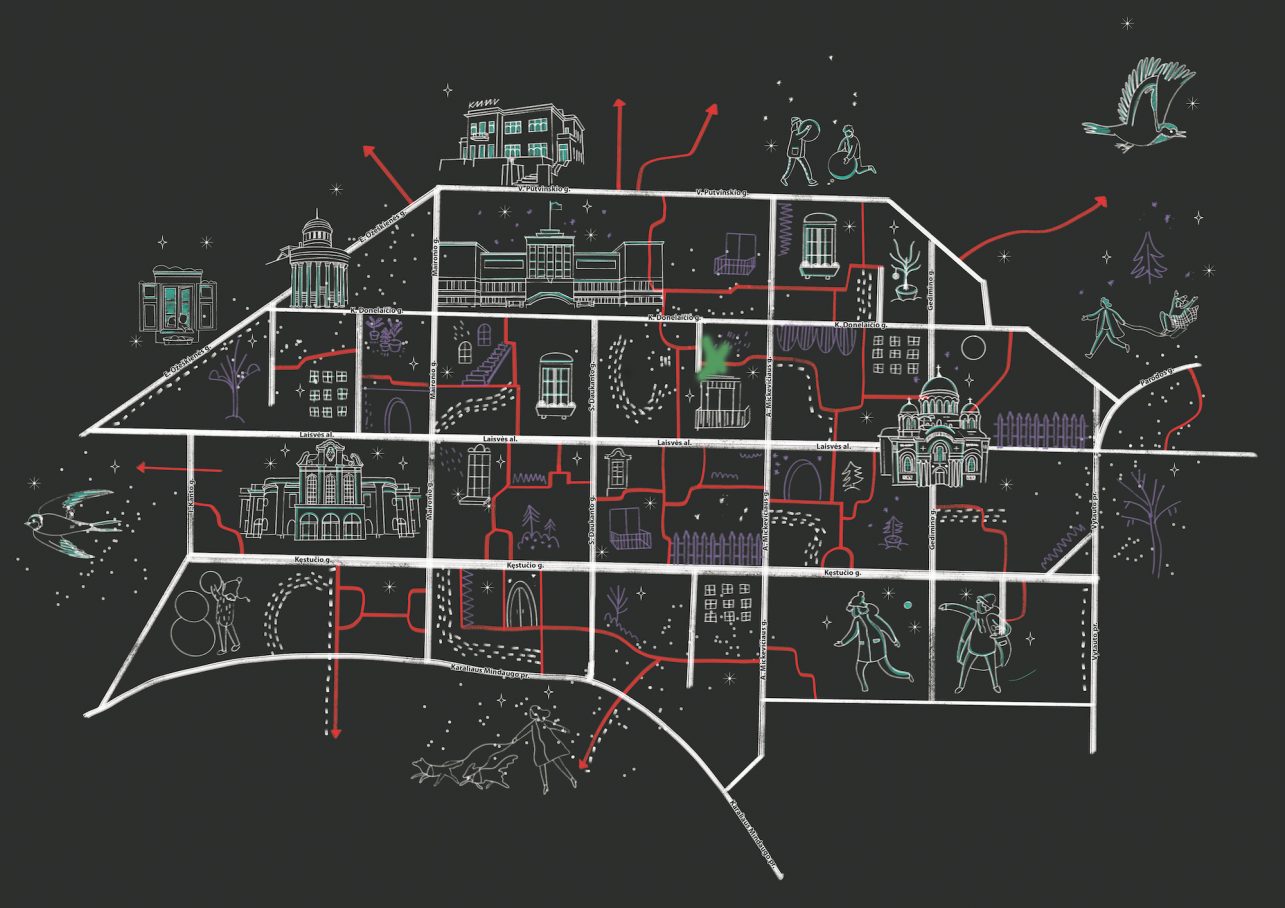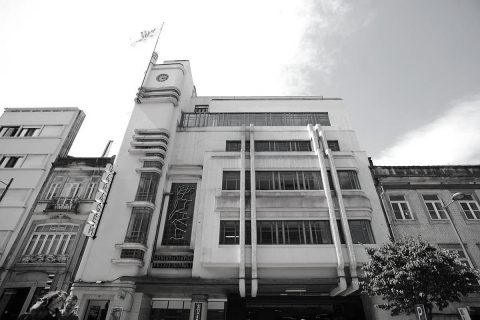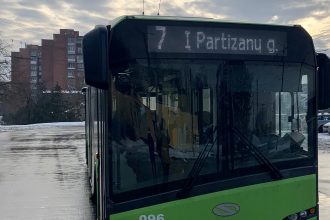“When I say, “thick depth”, I mean the image, when, instead of gardens, fields and forest behind the row of houses, you see other houses, courtyards, arches, gates, passages, connecting balconies, and tunnels. There are not many cities in Lithuania with intensively dense perimeter obstruction depth,” art critic Ernestas Parulskis said on the first Culture Week show on LRT Radio this year. And although his commentary was mainly dedicated to Vilnius, it forced at least two Kaunas residents to prick up their ears.
It was me and Žilvinas Rinkšelis, the coordinator of the Kaunas 2022 program Modernism for the Future. He is a guide, a historian and, most importantly, a hard-working Kaunas studies buff who does not limit his interest in the city to the working hours. Quite unexpectedly, the scheme of alternative movement in the New Town – that is, many opportunities to avoid the main streets of the centre and dive into the “thick depth” – drawn by Žilvinas, came into my hands. With the permission of the author, the scheme was interpreted by illustrator Gie Vilkė, and Žilvinas agreed to talk more about courtyard vectors.
How did the idea for this scheme come about?
I am an explorer of the city; I am curious about everything, whether I’m in my hometown or elsewhere. Listening to Ernestas Parulskis’ comment on the radio, I identified with his thoughts; I share the idea of going into a gateway if it’s open. I always take the opportunity to see the city from the inside, to check where one or the other passage leads. And in fact, sometimes I do end up in a blind alley and must turn around. But if it is possible to go through, I memorize this path to diversify my daily routes.
Of course, due to various circumstances, it is often necessary to choose the usual or the shortest road. And not always those newly discovered paths are shorter. But after walking the “usual” streets for a few days in a row, I get bored, and then I start looking for ways to break the monotony of everyday life.
I am constantly looking for new routes. Sometimes, people say they get bored of the same thing in the same city. I like to ask them if they tried all the roads.
Did you prepare the scheme systematically, or is it a multi-year project?
I couldn’t call it a project, but yes, the process is ongoing. The way I get to know about the city generally depends on where I live at the time, and in Kaunas, I have already managed to live in several districts. I focus my research on the place that I am staying.
New Town is related to my work, daily activities. Here, after home, I spend most of my time. It was best explored “for work reasons” because this is where I also do tours. The knowledge helps me in everyday life. I know how to save a few minutes when after leaving the Kaunas 2022 office, I find myself running late for a meeting at Kaunas Artists’ House.
It seems to me that there are less and less communicating courtyards in the city centre. Am I right?
Indeed. I drew the map a few weeks ago, and we can already put an X in one of the places: a passage from K. Donelaičio St. through a little alley of modernist houses to A. Mickevičiaus St, near Vingių Dubingių bar, has already been fenced. Interestingly, the passage was never “legal”; it just … was. Perhaps the owners did not legalize the plot, or it was not formed. And now it’s just fenced; the fences of the two estates are connected. So, it means we were passing through someone’s yard.
Another passage of uncertain status goes from Laisvės Avenue, through the former POST Gallery, to Kęstučio St., towards the Bocmanas bar. It leads through a kindergarten, the gates of which are unlocked at night. Once I was passing through it at night, after dark, and kept thinking: will the yard-keeper come out or not? It’s exciting. But so far, he hasn’t come out.

Why do people put up fences?
Although it is sad for those who have discovered the passages and enjoy cutting off corners, the position of the owners is clear and understandable – you don’t have to like it when people are buzzing back and forth outside your windows, especially if the land is yours. The fences are different, and their characteristics can tell a lot about the owners and their personalities. One of them is a blank brick wall above the eye level when it is impossible to see what is going on in the yard; the other is a light openwork fence, which creates a minimal restriction but does not close off from the world.
I haven’t done research on which type of fence is more prevalent. Maybe it depends on the time period. I have put down in my notes that there was a time at the very end of the 20th century when people were putting security bars over their windows, even on the third or fourth floors of the apartment building. This is related to the increase in crimes, which has improved significantly by now.
By the way, as far as I have talked about these issues with older Kaunas residents, it should be noted that during the years of Soviet occupation, there was basically no private property, a whole generation grew up without fences and limits, taking the fastest route. But people’s property should be respected.
A heritage management program has been operating in Kaunas successfully. It helps to restore life, smoothness, and colour to the main facades of historic buildings. And what buildings do we see “from behind” in the courtyards?
The front and rear facades are different. Of course, part of the buildings in the temporary capital were built by the well-off people of the time, but Lithuania was not a rich country, and the middle class was not wasteful; it saved where it was possible to save. On the places that you cannot see. Often the facade facing the street is plastered, but the part that is in the courtyard is just red bricks. In general, the rear facades are simpler. It is also interesting to see the stairwells of the servants in the courtyards. Today, when renovating a house, a less visible facade is often plastered as well, which improves the thermal properties of the building. A bare brick wall is not so durable, and it can be easily felt hundred years later. Although I personally like red bricks. If conditions allowed, I wouldn’t plaster it.
What do you personally find the most interesting in the invisible arteries of the city centre?
I would single out the yard of the Solo Society student housing on Kęstučio Street. I am interested in bridges between buildings, hanging passages or glass tunnels above the ground. There is one like that there. Another very interesting artefact of the late Soviet era can be found in the courtyard of the Žemprojektas building, at the intersection of Gedimino and V. Putvinskio streets. I think that that column-supported annexe should be exhibited.
Archaic mess is another beautiful thing. Like sheds and little gardens. I have read a lot about medieval courtyards of old towns that existed – not only in Kaunas – before “tidying up” and the sterilization of courtyards happened. It is quite a luxury to still have some of them left in the New Town. You walk down the main street, step into a gateway, and you are already in the courtyard. One of them can be found when walking past Bernelių užeiga restaurant towards St. Michael the Archangel’s Church. You can find an old development of the plots there, which existed before the emergence of the New Town. A manor once stood here. There are no remains of it, but the plots are shaped accordingly. There is a lot of greenery here, so during a warm season, you feel like in the 19th century. You don’t even hear the noise from cars anymore. The dome of the church can be seen protruding over the treetops, and there are small wooden houses around. As if you were looking at an old photograph, only in colour.




